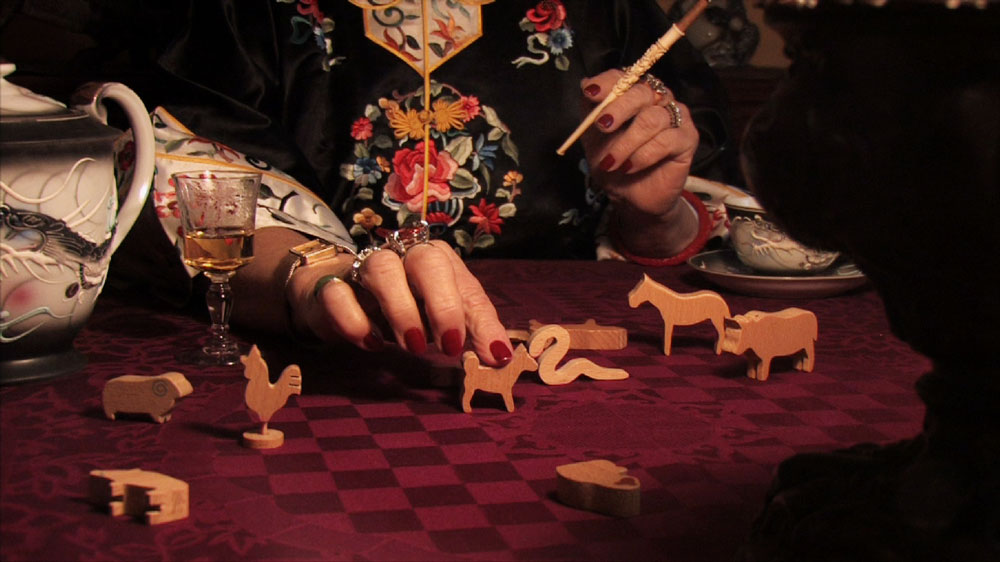A Voyage in Video (Through Film Art)
— Text by curator and researcher Pascale Cassagnau

“Interdisciplinary studies, of which we hear so much, do not merely confront already constituted disciplines (none of which, as a matter of fact, consents to leave off).In order to do an interdisciplinary work, it is not enough to take a “subject” (a theme) and to arrange two or three sciences around it. Interdisciplinary studies consist in creating a new object, which belongs to no one”, wrote Roland Barthes in 1972, in a text entitled “Jeunes chercheurs” (Research: The Young), published issue 19 of the journal Communications.
The “new object” described by Roland Barthes in this text on research is the definition of a project, which he goes on to christen as the “Text”.
This dispersed, scattered entity, which circulates from unique writings to unique writings over the course of time, gives rise to areas of adjacency and estrangement, of overlap and differences. The multiplicity of differential gaps, nevertheless, outlines a significant figure that is the antithesis of a unified figure. The parallel established by Barthes between the Text and interdisciplinary research in 1972 is still valid today when it comes to considering the fields of multimedia and video.
The field of video creation, much like what Roland Barthes described under the term “interdisciplinary studies”, is a platform for unique expressions, for diversified approaches, which does not exactly fall within the strict boundaries of film or video art, a notion which is, in itself, problematic in this day and age; rather, it falls within the purview of a new object: a scattered territory of aesthetic experiences that fall into points of convergence, between art and film, between film and performance, between video and sound creation, breaking down the borders between aesthetic fields.
Caught between numerous hypotheses on reality, history, and intimacy, the modern video creation of the last decade is not a transcendental field in and of itself. Rather, it is an undefined territory to which artists commit themselves as they do to photography, drawing, computer graphics, or objects.
Many of contemporary video works take up a number of such issues, displacing them in order to explore their utopian scope. This includes: the appropriation of diversified cultural sources from the world of mass media and the perspective of the network-based internet as context; the human time and auto-fiction of each individual; uniqueness and intimacy, reformulated at the scale of common time, between public space and private space; unique representations of the self, establishing a dialogue with the edition of the image, in this way making of montage, fragmentation and references to the filmic space its most decisive concerns.
For several years, the confluence of contemporary art and the documentary genre has proved to be particularly fertile ground. Indeed, this is due to the fact that documents and archives, as questions and methods, constitute a veritable frontier for the thinking behind contemporary creation. The emergence of documents within the economy of knowledge modifies — has modified, throughout the entire 20th century — the status of memory. Indeed, images provide memory with a support, a prism for reflection, which leads the gaze towards the object of memory and the memory of the object, given the ambiguity in their formulation. Moreover, documents give rise to types of assemblies and montages that act as the basis for the elaboration of stories, and forms of historicisation. The creation of archives raises a question on History and personal, unique stories. Such is the nature of the document: a use value for the re-appropriation of subjectivities, of forms of historicity, through the multiplication of tale hypotheses.
The generic program Comment ça va?, based on the eponymous film by Jean -Luc Godard (1978), and which has been developing throughout the last three edition of the LOOP Festival, presents documentary and documented films, highlighting their capacity to cross history, to recover truth and reality, not as their ultimate goals, but rather, as tools, as reserves of forms, to undertake a journey, a trajectory, a path through complex political geographies.
The selected works formulate a number of hypotheses regarding both revisiting some of the topoi in contemporary art as well as work-creation, the possibility for narration, and make good on the promise for “stories that demand to be told”, in the words of philosopher Paul Ricoeur in “Temps et Récit I”.
Curator and researcher Pascale Cassagnau presents the third of the programme Comment ça va? III, as a collaboration between LOOP, Le Fresnoy and CNAP. This year’s edition is constituted by a selection of films by João Pedro Rodrigues (Cinema Boliche, May 31), Safia Benhaim, Nicolas Boone and Hassen Ferhani (Zumzeig, June 5)